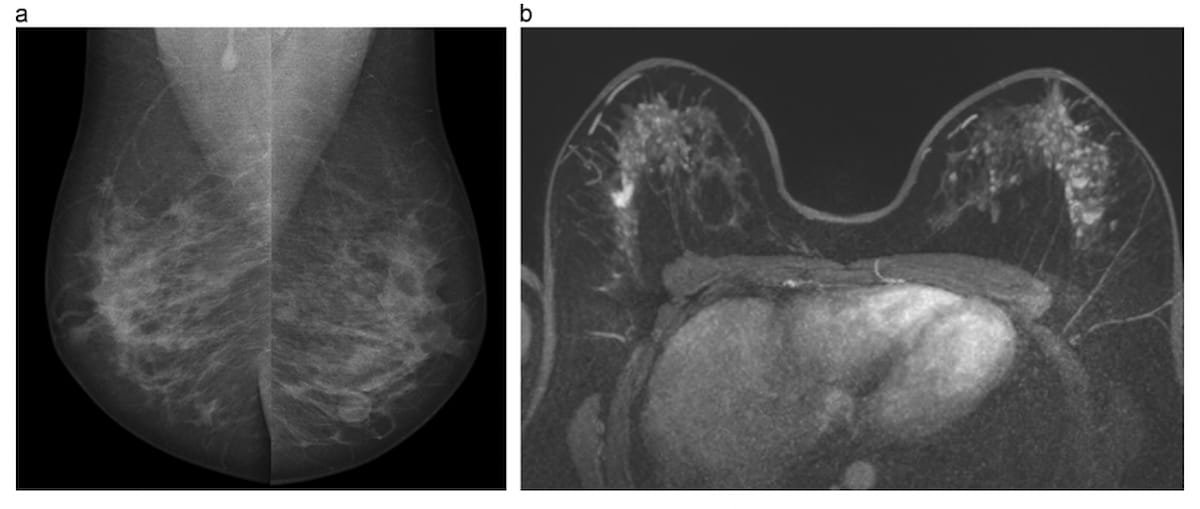Emphasizing a risk-stratified approach, the European Society of Breast Imaging (EUSOBI) has published breast cancer screening recommendations that emphasize the use of breast magnetic resonance imaging (MRI) for those at greater risk of developing breast cancer.
For the recommendations, published earlier today by European Radiology as part of the publication’s “ESR Essentials” series to provide streamlined guidance on clinical recommendations, the authors advocated annual breast MRI exams, beginning as early as 25 years of age, for women with increased genetic risk and those who have had prior chest radiation therapy.
Emphasizing the modality’s ability to detect neovascularity and more aggressive tumor subtypes, the EUSOBI also recommended supplemental screening with breast MRI every two to three years for women with extremely dense breast tissue. The authors of the recommendations emphasized that level I evidence has demonstrated cost-effective mortality reduction with breast MRI screening in this patient population.
Concurring with the recent breast cancer screening guidelines from the American College of Radiology (ACR), the EUSOBI also recommended breast cancer risk assessments to begin at the age of 25 in order to facilitate appropriate screening.
“Moving to screening programs adjusted to personal risk level instead of age-based population screening could improve the performance of a screening program by reducing underdiagnosis, false positives, and over-diagnosis as well as improving cost-effectiveness,” wrote study co-author Ritse M. Mann, M.D., Ph.D., who is affiliated with the Department of Diagnostic Imaging at Radboud University Medical Centre in Nijmegen, the Netherlands, and colleagues.
While acknowledging mammography as an overall screening mainstay, the EUSOBI claimed that digital breast tomosynthesis (DBT) can be a viable alternative for increasing detection rates and decreasing recall rates in high volume centers. The EUSOBI recommendation authors also pointed out that DBT may have limited impact for women with extremely dense breasts and has mixed results with respect to detecting interval breast cancer.
For women deemed to have average or intermediate breast cancer risk, the EUSOBI recommended annual mammography or DBT screening starting between the ages of 40 to 50 and approximately until the age of 70 depending on patient life expectancy.
Three Key Takeaways
- Personalized risk-stratified screening. EUSOBI recommends a risk-stratified approach to breast cancer screening, advocating for annual breast MRI exams starting as early as 25 years old for women with increased genetic risk or a history of chest radiation therapy.
- MRI for women with dense breasts. For women with extremely dense breast tissue, EUSOBI suggests supplemental screening with breast MRI every two to three years. MRI's ability to detect neovascularity and aggressive tumor subtypes makes it an effective tool in this population, with level I evidence supporting its cost-effective mortality reduction.
- Considerations for women with average to intermediate breast cancer risk. For women at average or intermediate risk, EUSOBI recommends annual mammography or digital breast tomosynthesis (DBT) screening starting between ages 40 to 50. Additionally, supplemental ultrasound and/or MRI imaging are suggested for those with category C and D breast density, although the balance between benefits and drawbacks of supplemental ultrasound remains a point of discussion.
While no supplemental imaging was recommended for women in this patient population with category A or B breast density, the EUSOBI suggested supplemental ultrasound and/or MRI imaging for those with category C and D breast density.
The researchers noted that for women with dense breasts, the literature has demonstrated that supplemental breast ultrasound increases the breast cancer detection rate and reduces the rate of interval cancers in comparison to mammography. However, remaining challenges with supplemental breast ultrasound in breast cancer screening include higher rates of recalls and biopsies along with a low positive predictive value (PPV), according to the recommendation authors.
“EUSOBI (European Society of Breast Imaging) guidelines suggest the possible usage of supplemental ultrasound screening in women at average or intermediate risk with dense breast and negative mammography, but the balance between advantages and disadvantages was not judged to be clear enough to adopt additional ultrasound as a general policy,” noted Mann and colleagues.
For those with average or intermediate risk and category D breast density, the EUSOBI recommended a breast MRI exam at least every four years from the age of 50 to 70.
(Editor’s note: For related content, see “New ACR Guidelines Emphasize Earlier Mammography Screening for High-Risk Women,” “Do the New USPSTF Recommendations Go Far Enough on Mammography Screening?” and “Five Takeaways from New Breast MRI Literature Review.”)
